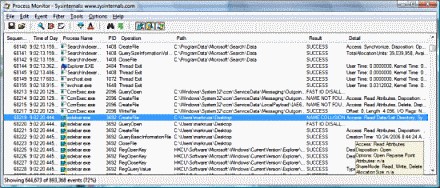

First you will need a copy of procmon (Process Monitor), which you can download from. CapturingĬapturing the data is very straight forward. To do this we can use the free "Process Monitor" tool and then load the output into SQL Server. In this article I will be show how to measure the quantity and size of I/O requests in each database as well as being able to work out where your I/O's are hitting and then matching those up with physical tables.

Understanding SQL's I/O patterns can help you design your disk infrastructure and knowing your application's patterns can help you get the most out of your disks. While SSD drives have been hailed as the future and fault tolerant ram drives are prohibitively expensive, most of us still use the humble mechanical disk drive to store and retrieve data. For those who are looking for more features like knowing if a process is safe or not and a better way to kill processes would be better to use another task manager like Auslogics Task Manager.The single most expensive native operation SQL Server can perform is reading and writing to the disk. It also doesn't do as good of a job at killing processes that some of the other alternatives do.Process Explorer is best for those who want a basic task manager replacement without wanting to install another piece of software on their computers. The only complaints I have with Process Explorer is it doesn't show you which processes are safe and which aren't. It also doesn't need to be installed to replace the task manager like the others do. It doesn't have all the features some of t he other task manager alternatives have but it has the basic features most need. Process Explorer is a good free basic task manager replacement.


 0 kommentar(er)
0 kommentar(er)
